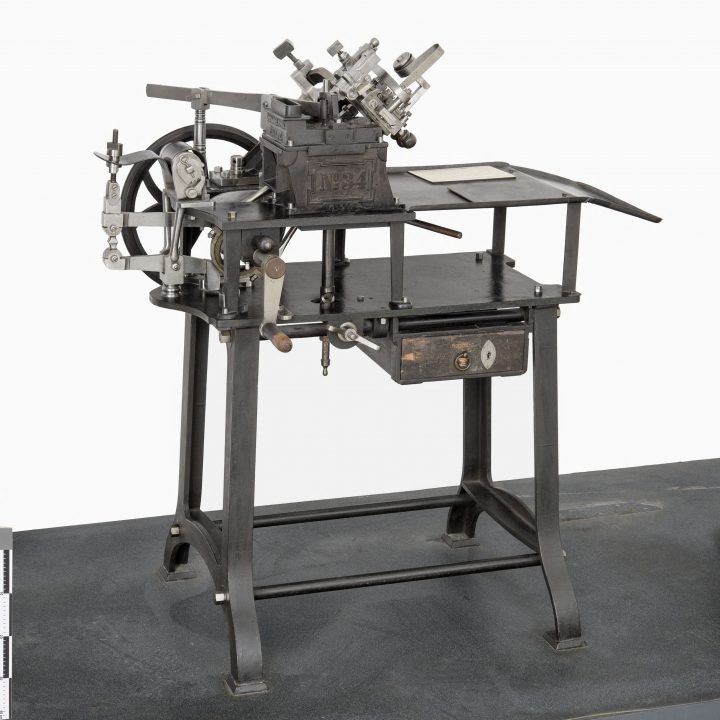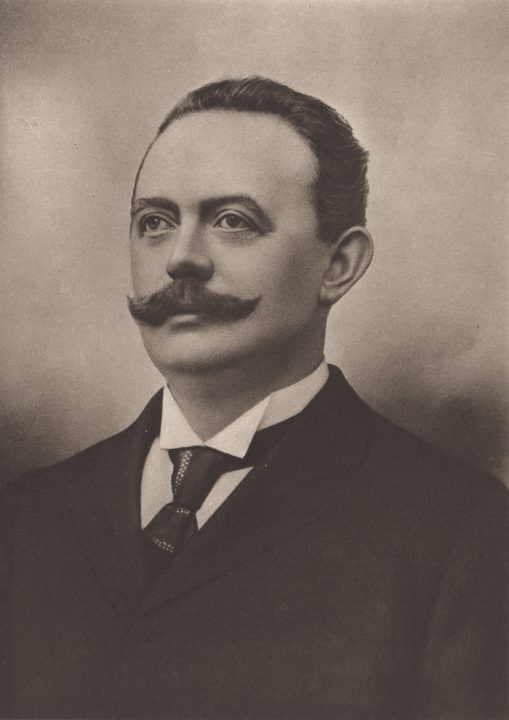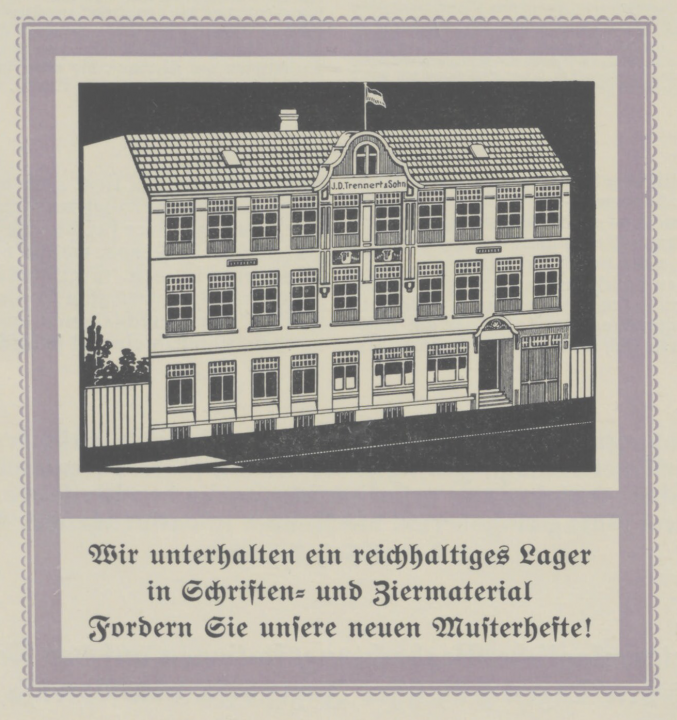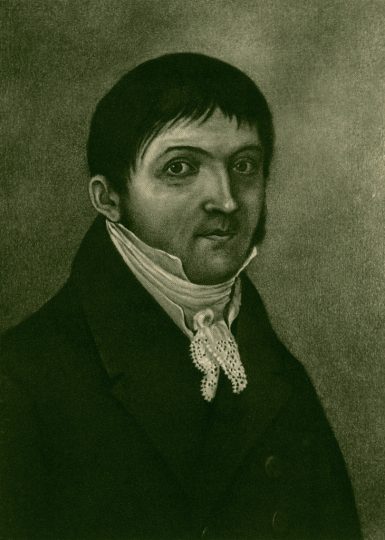This in the inaugural post for my Friedrich Bauer Project, a new series translating Friedrich Bauer’s Chronik der Schriftgießereien in Deutschland und den deutschsprachigen Nachbarländern into English, foundry by foundry. The book, a chronicle of typefoundries in Germany and neighboring German-speaking countries, was originally published in 1928. A project-landing page provides more explanation for the book and a link to this entry. Future entries will be linked to there, too.
For this project’s next post, I’ll tackle Bauer’s chronicle of Augsburg’s typefoundries, which follow Altenburg and Altona alphabetically. After that, I’ll move onto the Berlin typefoundries, which will take several posts. Since my project entries are not just straight translations but also include annotations, each new entry may take some time. Once I’m finished with Berlin, I’ll take a break from the foundries and post translations of Bauer’s forewords to each edition instead. Then, I’ll move onto his introduction before turning to Danzig (there are no German-speaking cities listed in the book that begin with the letter C).
About this post’s structure
The image above is reproduced from Friedrich Bauer’s Ursprung und Geschichte der Schriftgießerei J. D. Trennert & Sohn in Altona 1634–1925. It is a photogravure of an 1820 oil portrait of Johann Daniel Trennt. Everything that follows the next paragraph is my translation of pages 1–3 of Chronik der Schriftgießereien – except for the image captions, as Bauer’s book was not illustrated. I’ve also added notes to the text. Those appear at the bottom of the post. Do read the notes! Bauer’s chronicle can be bare bones at times. Chronik der Schriftgießereien runs alphabetically by city name, starting with Altenburg in Thuringia and ending with Zürich. Neither of the cities in this first post had more than one typefoundry listed in Bauer’s book.
To cut down on the number of total posts, I’m going to place several shorter entries together. Or, like I’ve done below, I’ll dock a short entry onto a longer one. Bauer’s foundry titles can sometimes seem like cryptic abbreviations. “Pierer” for Johann Friedrich Pierer’s printing house in Altenburg is pretty straightforward, but “Denecke – Andres – Trennert” was his attempt to list all three names the J. D. Trennert & Sohn foundry had while it operated in Altona. The company’s first owner was Johann Heinrich Denecke. After he died, his widow married again, and Johann Balthasar Andres took over the business. When he died, his widow must have arranged for their daughter, Anna Dorothea Friedrike Denecke, to marry Johann Daniel Trennert. When Trennert’s son died in 1876, the foundry passed into the hands of the Burchhardt family, who chose not to rename the business.
Altenburg (Thuringia)
Pierer
In 1799, the medical doctor Johann Friedrich Pierer (born in Altenburg on 22 January 1767, died on 21 December 1832) founded the Court Printing House Pierer (Stephan Geibel & Comp.) in Altenburg by purchasing the Court Printing House Richter, which had existed since 1595.[1] Today, the printing house operates a typefoundry for its own needs with automatic and pivotal casters.[2]
Altona (Elbe)
Denecke – Andres – Trennert
1785
The typefoundry founded in 1634 by the Stern printing house in Lüneburg came into the possession of the typefounder Christian Ulrich Fiebich in 1737.[3] After he died in 1757, it was continued by his heirs until the typefounder Johann Heinrich Denecke took it over in 1785 and relocated the business to Altona.[4]
1791, 1798
In 1791, Denecke married the widow of the copperplate engraver Johann Jakob Rolfsen, Anna Margarethe née Udorf. She continued to run the foundry after Denecke died in 1797. On 22 October 1798, she married the typefounder and punchcutter Johann Balthasar Andres, who thus became the foundry’s owner.
1809
J. B. Andres died on 18 January 1809, aged 39. His widow handed over the management of the foundry to the typefounder Johann Daniel Trennert, who had been born in 1784. On 16 September 1809, he married the foundry owner’s daughter from her second marriage, Anna Dorothea Friedrike Denecke. That made him a partner in the family business, which was rebranded as the Widow J. B. Andres / J. D. Trennert. Under Trennert’s management, the foundry experienced significant growth.
1821
The company’s oldest surviving type specimen is from 1821.[5] It includes 42 octave and two folio sheets. Many blackletter, roman, Hebrew, and Greek types, etc. are shown.[6]
1831
An 1831 specimen of borders and rules was printed with the company name “J. D. Trennert.”[7] In 1832, J. D. Trennert bought the property at Große Johannisstraße 45 to expand his business.
1834
In a handsome small quarto complete specimen published in 1834,[8] a fat face and its italic were advertised as the “latest” products.[9] As an improvement [in technological standards],[10] Trennert recommended introducing the typographic system based on the quarter petit. New printing houses were to be tacitly furnished according to this system.[11]
1846
In 1846, the then-newest, first German pivotal typecaster – built by Brandt – was set up.[12] The oldest and only surviving example of this machine,[13] carefully maintained by the company, has been restored in the foundry’s repair shop and is ready for use again. In 1914 it was exhibited at the Bugra, the Internationale Ausstellung für Buchgewerbe und Graphik at Leipzig.[14] Later, it was given to the Deutsches Museum in Munich.

Pivotal caster manufactured in Eduard Haenel’s Berlin typefoundry, ca 1845. Kept at the Deutsches Museum in Munich, this machine is probably the same model purchased by J. D. Trennert in 1846. According to the museum’s records, the machine depicted above came from Wilhelm Gronau’s foundry – the name Haenel’s Berlin business took in the 1860s. Photo: Deutsches Museum / Konrad Rainer, CC BY-SA 4.0.
1850
By 1850, the J. D. Trennert typefoundry could count most printers in northern Germany and the Nordic countries of Denmark, Sweden, and Norway among its regular customers. It occupied an outstanding position among typefoundries. It then suffered greatly from the insecurity caused by political circumstances and could not adapt to later developments in the industry immediately.[15]
1854
On 1 January 1854, J. D. Trennert made his son Johann Karl Adolph Trennert (born December 5, 1827) a partner in the company. Since then, it has been known as J. D. Trennert & Sohn. At that time, the foundry operated four typecasting furnaces and three casting machines.
1862
J. D. Trennert died on 4 January 1862. His son continued the business under its existing name. On 2 September 1867, [Johann Karl Adolph Trennert] became its sole proprietor.

Portrait of Johann Ludwig August Philipp Burchhardt, who apprenticed as a typecacaster at J. D. Trennert & Sohn from 1872 to 1876, and then managed the company until his death in 1922. From Friedrich Bauer’s Ursprung und Geschichte der Schriftgießerei J. D. Trennert & Sohn in Altona 1634–1925 (1925), n.p.
1876, 1882
Johann Karl Adolph Trennert died on 22 February 1876. The foundry came into the possession of Anna Engelbrecht,[16] the widowed Mrs. Burchhardt.[17] She entrusted its management to her son, the typefounder Johann Ludwig August Philipp Burchhardt (born on 1 January 1857 in Altona).[18] He was endowed with the ability to bring the business out of its troubles and make it efficient again. The continuous expansion that began at this time bears eloquent testimony to the upswing. In 1882, a new building was erected for the typefoundry,[19] which was enlarged in 1904.
1906
Johan Burchhardt managed his mother’s foundry completely independently for thirty years but only as her authorized representative. On 25 January 1906, he became the sole owner of the company. In March 1907, it was able to move into a larger new factory building, erected next to the old one, at Schauenburgerstrasse 5.

Illustration of the J. D. Trennert & Sohn factory in Altona, shown at the back of the ca 1930 specimen brochure Fraktur-Schriften: Hansa-Fraktur, Ideal-Fraktur, Goethe-Fraktur und ältere Schnitte. Staats- und Universitätsbibliothek Hamburg PPN 1764148126.
1923
Johann Burchhardt died on 11 April 1922, his son Paul Friedrich Burchhardt (born December 19, 1883), who had worked in the company since 2 January 1906, initially took over the business for the heirs. On 1 January 1923, he became the company’s sole owner.
1925
In a dapperly designed 1925 memoir, Friedrich Bauer summarized the history of the J. D. Trennert & Sohn company from its origins onward.[20] It could be proven that the foundry had existed in uninterrupted succession from 1634.
1926, 1928
By installing new machines, setting up an in-house printing unit, and introducing many improvements, the foundry was able to become more efficient. It undertook the cutting of its own typefaces. Heinz König designed Wiking for the foundry, and Friedrich Bauer designed Trennert-Antiqua, together with italics and display styles. A script typeface named Trocadero was well received, and other products were in the making.
Postscript
Friedrich Bauer’s chronicle of the company’s history ended in 1928 when the second edition of his Chronik der Schriftgießereien was published. Hans Reichardt placed an additional timeline as a three-page PDF on the Friends of the Klingspor Museum website, covering 1926 to 1962. Klaus-Peter Gerlach provides a narrative history of the firm in his 1995 book Geschichte der Hamburgischen Schriftgießereien.[21] Like Friedrich Bauer’s Ursprung und Geschichte der Schriftgießerei J. D. Trennert & Sohn in Altona 1634–1925, this is a much thorougher account of J. D. Trennert & Sohn than that given here. The foundry was never a large company; it had 55 employees in 1925 – perhaps the high point in its long history.[22] In 1926, Gebr. Klingspor had 368 employees.[23] Germany’s large foundries – like the Bauersche Gießerei, Schelter & Giesecke, and D. Stempel AG – had significantly more than that. H. Berthold AG in Berlin claimed to be the largest typefoundry in the world.[24]
When Paul Friedrich Burchhardt died in 1937, his wife Alice Burchhardt took control of the business. According to the sources I mentioned above, the typefoundry building was destroyed during the Allied bombing of Hamburg in 1943. Nevertheless, as Ferdinand Ulrich discovered, the factory’s shell seems to have survived the war or been rebuilt. After losing its factory, the J. D. Trennert & Sohn management moved operations into another workspace and attempted to recover the business. Carl Lange, a managing director of the firm, left J. D. Tennert & Sohn – a few years later, he was working for Genzsch & Heyse. Walter Burchhardt, who was Alice Burchhardt’s brother-in-law, attempted to file for bankruptcy in 1953. A short-lived attempt was made to start a successor firm called the Hamburger Schriftgießerei. In 1962, J. D. Trennert & Sohn’s name was finally removed from Hamburg’s business registry.[25]
Typefaces
Already in 1923, J. D. Trennert & Sohn had entered into a matrix-sharing program with Schriftguss AG and C. E. Weber in Stuttgart.[26] Ferdinand Ulrich writes that most of the foundry’s surviving typefaces went to Genzsch & Heyse in 1953, including the 1934 sans-serif family Friedrich-Bauer-Grotesk. Several J. D. Trennert & Sohn typefaces have been revived in the 21st century, including Friedrich-Bauer-Grotesk (as FF Bauer Grotesk) and Wiking. Stephan Müller and Raymund Schröder are reviving Trennert-Antiqua for Forgotten Shapes, and some years ago, I was part of Jan Middendorp’s Fust & Friends initiative, which published a revival of Alarm designed by Andreas Seidel. The foundry’s 1930 type-specimen catalog has been digitized by the Staats- und Universitätsbibliothek Hamburg. It has digitized six other specimen brochures from Trennert, too – all from the 1920s and ’30s.
Notes
- I’ve decided to use “Court Printing House”.as a translation for Hofbuchdruckerei.
- This Altenburg printing house is still in business today. There is a more-detailed English-language Wikipedia page on its history, if you’re interested.
- The Frankfurt University Library has digitized a 1744 specimen sheet for printers’ roses from Fiebich. In Fiebich’s time, a “typefounder” was a man trained in making fonts of printers’ type. In other words, in the casting of the letters. After 19th-century mechanization, one might call the industrialist who owned a type-making factory a “typefounder.” Meanwhile, the men who stood at the casting machines producing the letters could be best described as “type casters” (although the machines they labored on are also described by this term).
- Today, Altona is part of Hamburg. Yet, it only became a city district in 1938. The Hamburg city-state is sandwiched between the German federal states of Lowery Saxony and Schleswig–Holstein. Until 1864, Schleswig–Holstein was part of the Kingdom of Denmark. Before the Second Schleswig War in 1864, Altona was part of Danish-controlled Holstein. It passed under Austrian control in 1865. Following Prussia’s victory in the Austro-Prussian War of 1866, Altona became part of the newly-formed Prussian Province of Schleswig-Holstein in 1867.
- The Royal Danish Library holds a copy of this. According to Nikolaus Weichselbaumer’s Deutsche Schriftproben der Handpressenzeit, the Royal Library in Stockholm’s collection includes an even earlier specimen from the time of Johann Balthasar Andres.
- Most of the roman and italic types were from Justus Erich Walbaum in Weimar; Trennert purchased duplicates of Walbaum matrices in 1818. See Friedrich Bauer, Ursprung und Geschichte der Schriftgießerei J. D. Trennert & Sohn in Altona 1634–1925 (Altona: Privatdruck der Schriftgießerei J. D. Trennert & Sohn, 1925), p. 12.
- A copy of this specimen may be viewed at the German National Library.
- A copy of this specimen may be viewed at the Kunstbibliothek in Berlin.
- The exact German terminology here is “fette englische Antiqua und Kursiv” – literally a bold English roman and italic.
- For this, Friedrich Bauer is citing J. D. Trennert’s forward to his 1834 specimen.
- In the 1870s, a quarter petit – or Viertelpetit – was codified as a unit of typographic measurement equalling to two Didot points. However, in 1834, it would have simply been a quarter of the Petit body size, the traditional size of type that would later be defined as 8-point in height. For Trennert, internally standardizing a Viertelpetit allowed for his product sizes to be systematized. For instance, the type size historically called Nonpareil could now be denoted as three Viertelpetit. Petit would be four Viertelpetit, Mittel seven Viertelpetit, etc. One might ask why Trennert did not adopt simply the French Didot-point system. However, single-point jumps in type sizes are rare in letterpress printing. They are generally restricted to 7-point and 9-point sizes, which were rarities even in the 20th century (although Trennert had them and called them 3 1/2 and 4 1/2 Viertelpetit). A scheme with a two-unit base made sense in an environment that had not yet universally adopted the metric system or the Didot point.
- Lauritz Brandt stole the design of the pivotal typecaster that David Bruce Jr. had developed in New York in 1838. He sold copies of the machine to European foundries. Friedrich Bauer did not mention this in Chronik der Schriftgießereien, which perplexes me somewhat, as an article refuting Brandt’s claim from Bruce himself was published in the Journal für Buchdruckerkunst in 1870 [columns 429–431].
- The German term for Bruce’s pivotal caster is a Handgießmaschine.
- Organized as an international exhibition devoted to all aspects of the book trades, it is perhaps of little surprise that German typefoundries were among the exhibitors at the Internationale Ausstellung für Buchgewerbe und Graphik (or Bugra for short). German Wikipedia provides an online overview of the fair.
- Gerlach lists a number of possible explanations for the “political circumstances” that caused economic insecurity at J. D. Trennert; see Klaus-Peter Gerlach, Geschichte der Hamburgischen Schriftgießereien J. D. Trennert & Sohn, Genzsch & Heyse, J. John Söhne (Hamburg: Im Auftrag des Museums der Arbeit von Klaus-Peter Gerlach, M. A., 1995, pp. 39–43 – although Gerlach’s statement that the foundry was one of the largest in Germany around 1854 is gravely inaccurate. Surely, one cause of the troubles at this time must have been the “Schleswig-Holstein Question,” or the dispute regarding these territories that unfolded between 1848 and the 1860s. Perhaps apocryphally, the British Prime Minister Lord Palmerston is reported to have said that the Schleswig-Holstein question was so complicated that “only three men in Europe have ever understood it. One was Prince Albert, who is dead. The second was a German professor who became mad. I am the third, and I have forgotten all about it.” See https://en.wikipedia.org/wiki/Schleswig–Holstein_question.
- Gerlach p. 43 (see note 13) calls Ms. Engelbrecht “Catharina Maria Engelbrecht” and “Katharina Maria Engelbrecht,” without providing a source.
- This passage is not incredibly straightforward. Johann Karl Adolph Trennert’s siblings predeceased him. None of them had any children, so there were no Trennert’s left to inherit the foundry. In his will, Johann Karl Adolph Trennert left J. D. Trennert & Sohn to Anna Maria Engelbrecht. Born Anna Maria Eggers, this inheritee was in her second marriage. After the death of her first husband – a Mr. Burchhardt, with who she had at least one child – she wed a Mr. Engelbrecht. See Bauer 1925, p. 41 (note 4 above).
- At the time of Johann Karl Adolph Trennert’s death, Johann Ludwig August Philipp Burchhardt was nearing the end of his typecasting apprenticeship at J. D. Trennert & Sohn. That a 19-year-old apprentice was trusted with the management of the company shows how small the firm must have been in 1876. Indeed, there seem to have only been three other typecasters at this time. Ibid., p. 42. In 1883, Genzsch & Heyse – across the border from Altona in Hamburg – had 68 employees, more than 20 of whom were typecasters.
- Burchhardt had the money to construct a new building because of his marriage to Alida Cornelia Ockelmann; see Gerlach p. 44 (note 13 above). By this point in the chronicle, it should be obvious how important the women in the foundry’s ownership were to its continuation. This is a situation that will repeatedly occur throughout Chronik der Schriftgießereien.
- This is Bauer 1925, mentioned above in note 4.
- Gerlach pp. 21–63 and 175–197 (note 13 above).
- Ibid., p. 58.
- Hans Aldof Haley, Karl Klingspor: Leben und Werk (Offenbach am Main: Vereinigung „Freunde des Klingspor-Museums“ e.V., 1991), p. 18.
- See the title page of a folder Berthold put together for the Indian market, kept in the Historisches Archiv at the Stiftung Deutsches Technikmuseum Berlin as III.2-24185.
- Gerlach pp. 61–63 (note 13 above).
- Hans Reichardt, “Nachtrag A,” www.klingspor-museum.de/KlingsporKuenstler/ChronikSchriftgiessereien/Chronik_NachtragA.pdf. Accessed 13 August 2023.
